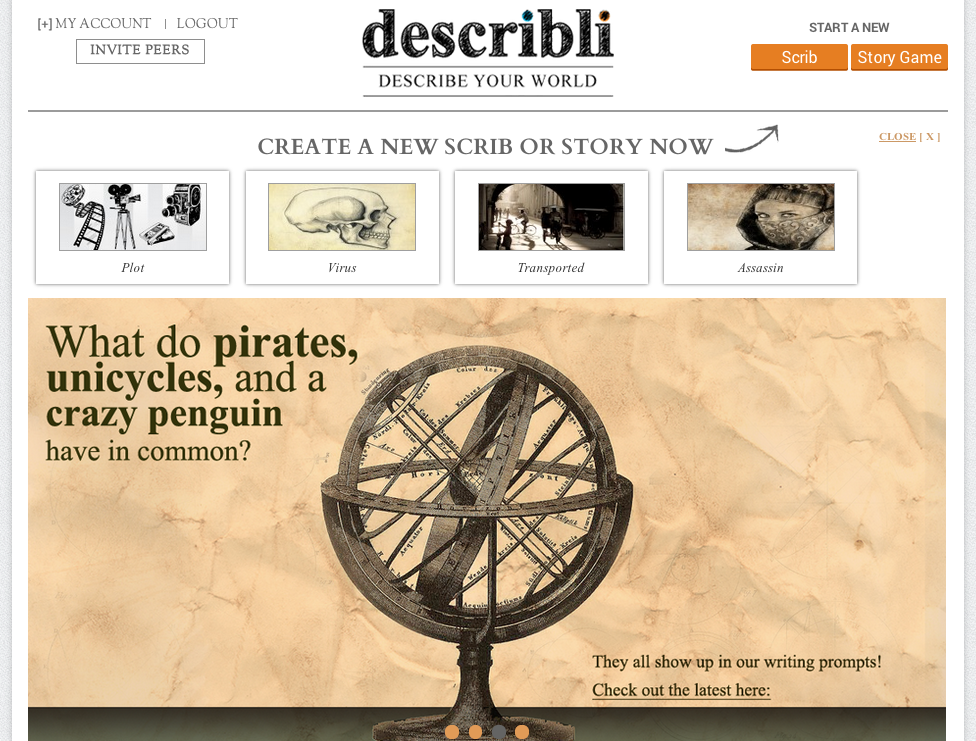For any casual visitor to Describli, the website is filled with stories — little bite-sized pieces of fiction that the site calls “scribs.” But to founder and CEO Laura Fredericks, the website itself is a story. A story of change and growth and of learning to be a better listener.
Describli, founded in 2012 but live now for just over a year, is an online writing community. “We help authors, and really any writers, connect with their readers through daily writing prompts,” Fredericks said in a recent interview with Technical.ly DC.
Describli grew from the idea that the publishing system is broken.
Authors, or would-be authors, need a better way to develop their writing and their community of readers. It is problematic that writers must spend so much time marketing their work when what they really want to be doing is writing — and Describli wants to be part of the solution.
“The idea is to get people to have a following for their work, and grow an audience for their work, before they publish so that by the time they do publish they already have a group of people who will buy their stuff,” Fredericks said.
Today, Describli users visit the platform to respond to one of four daily writing prompts (created by Fredericks). Writers can respond individually, or challenge another writer to a “story game” — a collaborative effort where writers switch off writing short paragraphs until the story reaches its conclusion.
But in one of Fredericks’ original ideas for the site, this game component was much larger. Fredericks, who has a background in theater and improv, envisioned a massive ongoing multi-player story. But this turned out to be logistically complicated, so the focus of Describli changed, for now.
“We still might go back to that,” Fredericks said.
Another idea was to add a competitive element to the site by allowing readers to rate pieces of writing according to various metrics and compile this into a “leaderboard” on the homepage. Fredericks says she was enthusiastic about this idea, because it was exciting from a coding perspective.
But while the leaderboard exists today, it is nowhere near the homepage. Why? “We realized that from a writer’s perspective that’s a whole bunch of ways to feel bad about yourself,” Fredericks says.
This is how the evolution of Describli works — Fredericks likens her initial ideas to hypotheses and the feedback she gets from the community of writers to results. “We always go with the results,” she said. Because in the end, a community for writers is really all about the writers. Fredericks says she’s constantly testing out new tweaks, and attending live events with writers and authors to ask what features potential users would like to see.
Describli currently has around 700 writers, and is growing. Even so, it is nowhere near as large as online writing community competitors such as WattPad, which has 40 million users. But when it comes to the long-term goals of Describli — changing publishing by giving writers a way to develop a community following — Fredericks seems to prefer thinking about “competitors” as potential collaborators.
“One of the really cool things about startups in the last five years or so is they’re starting to realize that it’s not a zero-sum game,” she says. “As we move forward we’re just as interested in thinking about collaboration and partnering with people as we are interested in thinking about competition.”
Curious about Describli but don’t want to write? The literary hipsters among you can use Describli as a place to discover new writers before they ever publish. According to Fredericks, readers are “some of the strongest users. They’re there to really tell people what they think and feel like they’re part of the process.”
Before you go...
Please consider supporting Technical.ly to keep our independent journalism strong. Unlike most business-focused media outlets, we don’t have a paywall. Instead, we count on your personal and organizational support.
3 ways to support our work:- Contribute to the Journalism Fund. Charitable giving ensures our information remains free and accessible for residents to discover workforce programs and entrepreneurship pathways. This includes philanthropic grants and individual tax-deductible donations from readers like you.
- Use our Preferred Partners. Our directory of vetted providers offers high-quality recommendations for services our readers need, and each referral supports our journalism.
- Use our services. If you need entrepreneurs and tech leaders to buy your services, are seeking technologists to hire or want more professionals to know about your ecosystem, Technical.ly has the biggest and most engaged audience in the mid-Atlantic. We help companies tell their stories and answer big questions to meet and serve our community.
Join our growing Slack community
Join 5,000 tech professionals and entrepreneurs in our community Slack today!

The person charged in the UnitedHealthcare CEO shooting had a ton of tech connections

From rejection to innovation: How I built a tool to beat AI hiring algorithms at their own game

Where are the country’s most vibrant tech and startup communities?



